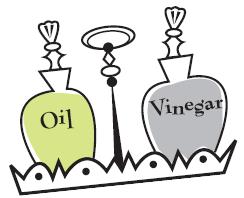How It All Vegan!: Irresistible Recipes for an Animal-Free Diet (5 page)
Read How It All Vegan!: Irresistible Recipes for an Animal-Free Diet Online
Authors: Tanya Barnard,Sarah Kramer
Tags: #Social Science, #Cooking, #ebook, #Vegan Cooking, #Vegan Cookery, #Vegetarian & Vegan, #Veganism, #book, #Agriculture & Food

• Host a vegan potluck birthday party: the best way to celebrate life!
• Make a dish for a friend: if a friend is laid up, just had a baby, or down in the dumps, make them something to eat! Share your favourite recipe and pass on your love and your love of food!
• Make vegan food for a charitable organization. Share the wealth!
• Visit your grandma or someone in a nursing home and bring some vegan cookies!
Enjoy Yourself
Life is a gift. Don’t be so serious. Jump in a puddle. Host a potluck meal. Take your neighbour’s dog for a walk. Pet a cat. Go to an animal rights meeting. Pick up some trash. Each day offers you a chance to be a better vegan, and a better person. Cherish yourself and the things around you. At first it may seem difficult, but once you take your first step, you’ll be well on your way to becoming a vegan warrior.

Vegan versions of foods traditionally made with animal products are great not only for vegans, but for those who suffer from food allergies as well. Here is a list of vegan substitutes for eggs, peanut butter, and milk, as well as lists for variations on staples such as flour and sugar. There are also hints for that great mother of all food substitutes, tofu. Going vegan or having allergies can be a challenge; again, imagination is the key.
EGGS
The following are some healthy alternatives to high-cholesterol eggs. Each of these substitutions has a distinct flavour and method of use. Experiment with them all when cooking and baking to see how they can be used.
•
Flax Eggs
(2 tbsp ground flax + 3 tbsp water = 1 egg)
Flax is great for pancakes, breads, and other baking.
• Ener-G Egg Replacer (1½ tsp + 2 tbsp water = 1 egg)
Most health food stores carry egg replacer.
• ½ banana, blended or mashed = 1 egg
Bananas are great egg substitutes for desserts, or sweet items like pancakes or smoothies.
• ¼ cup tofu = 1 egg
When using tofu as an egg substitute, ensure you’re using soft tofu, and a food processor, so you don’t get any grainy bits.
• 3 tbsp apple sauce = 1 egg
Like bananas, apple sauce is great for sweeter recipes.
• 1 tbsp psyllium husks + 2 tbsp water = 1 egg
The longer you let the psyllium husks sit in water, the more they become an eggy substance. Terrific in breads and baking.
MILK
Humans consume cow’s milk as a beverage but it was designed for baby cows, not humans. There are so many milk substitutes out there on the market, and each brand has its own taste. Try them all and find the ones you like best, or better yet, try making your own.

BUTTER
Butter is made from churning whole milk or cream until the fats separate and form a solid mass. It has a high salt and saturated fat content and is thought to contribute to heart disease. These substitutions offered not only are nutritious, but taste great in baking, too.
• Soy lecithin spread
• Store-bought margarine such as Earth Balance Natural Buttery Spread (which is 100 percent vegan) or other margarine, but make sure you check the ingredient lists of other brands, as they may contain animal products.
• Flax oil
Don’t use this for baking or cooking, but as a topping for potatoes, rice, popcorn, etc.
• Nut butter
Can be made from almonds, cashews, or other nuts.
• Vegetable shortening
Use for making pastry.
• Applesauce
Use for baking only; can replace up to ¾ of butter in a recipe.
CHEESE
There are hundreds of varieties of cheeses offered throughout the world. Sadly, only a few varieties of “mock” cheeses made from rice or soy are available; sadder still, even fewer brands offer vegan versions. (Some brands contain casein, which is an animal by-product.) Check the ingredients before buying your mock cheese, which is available in most health food stores.
• Soy, rice cheese
• Soy, rice Parmesan cheese
PEANUT BUTTER
Peanut butter is the most familiar and common nut butter around. But many people are severely allergic to peanuts. It is possible to enjoy the same rich flavouring as peanuts by substituting any of the seed butters located in the list below. Different nuts and seed butters have different tastes, so experiment with them all and choose your favourite. Here are a few examples available in most health food stores.
• Tahini (sesame seed)
• Almond butter
• Cashew butter
• Sunflower seed butter
SUGAR
Here are a few examples of natural alternatives to those white and brown granules found in most homes. Generally found in most health food stores, these alternatives offer a more holistic and healthy approach to sweetening your foodstuffs. Remember that when using a liquid sweetener, you must cut back a little on the other liquid in the recipe.
• Maple syrup
• Cane sugar
• Date sugar
• Barley malt
• Fruit juice concentrate

FLOUR
Wheat is the most popular grain in the North American diet. It is used to make bread products, as a thickening agent – the list goes on and on. Your local health food store probably offers a number of grains that can be used in place of wheat, each one having a different flavour and density. Try them all. In addition to these different kinds of flour, you can make your own in a blender or a food processor. For example, you can make oat flour by blending rolled oat flakes until powdered.
• Spelt flour
Tends to make your recipes heavier; you can slightly increase the baking powder so that it rises more. Good for bread and baking.
• Kamut flour
Good for bread and other baking; best if used half and half with other flours.
• Barley flour
Good for pancakes, cookies.
• Buckwheat flour
Good for pancakes, but is a heavy flour so use half and half with other flours.
• Oat flour
Good for breads, cookies.
• Brown rice flour
• Corn flour
• Millet flour
A dry, coarse flour.
• Potato flour
• Soy flour
Has a strong flavour.
• Chickpea flour
Has a strong flavour.

OIL
Oil is an essential part of the daily diet, needed for a variety of purposes to keep the body healthy and strong. Generally, oils are used in baking, cooking, or as a topping on rice or salad. Try to use organic coldpressed oil, which can be found in most health food stores.
• Olive Oil
The best oil there is. Splurge a little, because it’s worth it! We even use it in our baking, but it does have a distinct flavour, so you may want to use sunflower oil when you bake.
• Sunflower oil, safflower oil, canola oil, vegetable oil
These are cheaper oils that can be used for basically anything.
• Sesame oil
Has a strong taste; not good for frying. Excellent oil for salads and Asian recipes.
• Flax oil
Don’t cook with this oil! Use it for salads, or in place of butter on popcorn, potatoes, and rice.

SALT
Increasing levels of salt in the North American diet in the last few decades have led to wide concern. Salt finds its way into our lives by means of flavour enhancers and food preservatives. Instead of reaching for the salt shaker, replace it with these nutritious substitutions.
•
Gomashio
A condiment made of roasted sesame seeds. Use on cooked vegetables, salads, soups.
• Braggs
Liquid aminos! Braggs, an all-purpose seasoning brand, is formulated vegetable protein made from pure soybeans and purified water. Great on salads and dressings, soups, veggies, rice and beans, tofu, stir-fries, tempeh, casseroles, potatoes, vegan jerky, popcorn, gravies, and sauces.
TOFU
Tofu is a white, semi-solid product made from soy milk and a curdling agent. Tofu by itself is almost tasteless. It can be used as a filler or substitution or on its own. Think of tofu as a sponge: it will soak up whatever it’s surrounded by. Tofu is high in protein and calcium, low in fat and sodium, and cholesterol-free.
There are many kinds of tofu. Which one to use depends on your recipe:
•
Firm:
Good for stir-fries, scrambled tofu, tofu jerky.
•
Medium:
Easily blended; good for stir-fries, scrambled tofu, tofu jerky, sauces, desserts.
•
Soft and silken:
Very easily blended; good for desserts, dips, sauces.
•
Tempeh:
Not a kind of tofu, but a somewhat meat-like substance made from cultured soybeans. It is used in dishes like
chicken salad
or in barbecuing, and has a rather strong taste compared to tofu.
•
TVP or Textured Vegetable Protein:
A soy product that comes in granules or chunks. Rehydrate it in water (1 cup of TVP in cup water; add more water if necessary) and use in place of ground meat as in chili. It takes on the flavour (somewhat) of whatever you cook it with.
cup water; add more water if necessary) and use in place of ground meat as in chili. It takes on the flavour (somewhat) of whatever you cook it with.